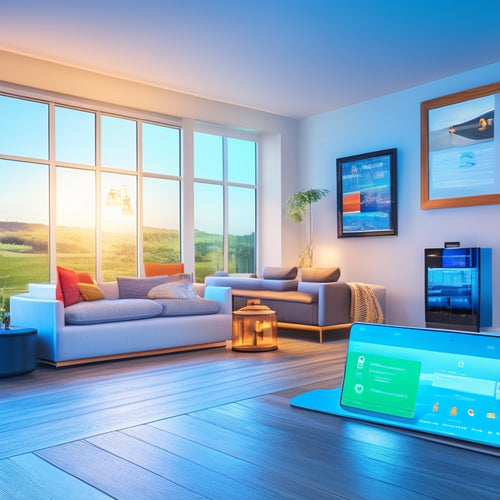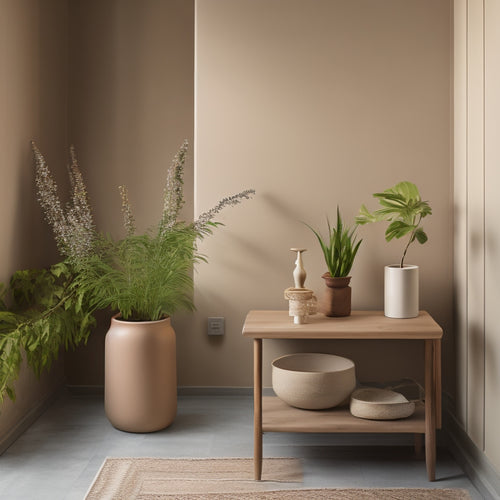
Power Strip Hacks: 5 Tips for Energy Efficiency
Share
By upgrading to smart plugs, you'll track energy consumption in real-time, revealing high-power devices and opportunities for energy savings. Unplugging devices from power strips helps identify vampire devices drawing standby power, and scheduling shut-off prevents waste. Prioritize energy-hungry devices like desktop computers and TVs, and optimize power strip placement using the "golden triangle" rule to reduce cord clutter and overheating risks. By implementing these hacks, you'll reduce energy consumption, lower utility bills, and minimize your carbon footprint. Now, uncover how to take your energy efficiency to the next level by exploring the finer details of each technique.
Key Takeaways
- Use smart plugs or energy monitors to identify energy-hungry devices and reduce standby power consumption.
- Prioritize device placement on power strips, reserving high-rated strips for energy-intensive devices like desktop computers and large TVs.
- Schedule power strip shut off during periods of inactivity to prevent standby power waste, especially for devices like TVs and gaming consoles.
- Optimize power strip placement using the "golden triangle" rule to reduce cord clutter, energy loss, and overheating risks.
- Unplug or replace vampire devices that draw power even when turned off, and consider using solar-powered solutions to decrease reliance on traditional energy sources.
Smart Plug Energy Monitoring
By plugging your devices into smart plugs, you're taking the first step towards gaining useful comprehension into your energy consumption. This understanding allows you to identify areas where you can cut back and optimize your energy usage.
One of the significant smart plug benefits is the ability to track energy consumption in real-time, providing you with detailed information on which devices are using the most power. By adopting renewable energy sources, such as solar and wind power, you can further reduce your carbon footprint and energy costs.
With this knowledge, you can make informed decisions about which devices to unplug or replace with energy-efficient alternatives, ultimately leading to significant energy savings. By monitoring your energy usage, you'll be able to identify opportunities to reduce your carbon footprint and lower your energy bills, giving you more control over your energy consumption and more freedom in your daily life.
Identify Vampire Devices Easily
You've likely heard of "vampire devices" - those sneaky appliances and gadgets that continue to draw power even when turned off but still plugged in.
These devices are responsible for a considerable amount of energy consumption in your home. In fact, with the growing adoption of electric vehicles, it's crucial to optimize energy efficiency in our daily lives, considering the environmental impact and sustainability concerns associated with EV battery production.
To identify vampire devices, try this simple trick: unplug all devices from your power strip, then plug them back in one by one. Use a smart plug or an energy monitor to track the energy consumption of each device.
You'll be surprised to find which devices are secretly sucking power. By identifying and unplugging these vampire devices when not in use, you can greatly reduce your energy consumption and save money on your utility bills.
Schedule Power Strip Shut Off
Time-of-use optimization is key to accessing the full potential of your power strip. You can schedule your power strip shut off when devices aren't in use to prevent standby power consumption.
Additionally, incorporating renewable energy sources into your daily routine can further reduce your carbon footprint. Consider investing in power strips with automatic timers or remote control capabilities.
This allows you to program specific times for your devices to turn on and off, ensuring you're not wasting energy when they're not in use. For example, you can set your TV and gaming console to turn off during the night when you're sleeping.
Prioritize Energy-Hungry Devices
Identifying energy-hungry devices plugged into your power strip is essential for optimizing energy efficiency. By prioritizing these devices, you can reduce overall energy consumption.
| Device | Energy Consumption (Watts) |
|---|---|
| Desktop Computer | 65-250 |
| Gaming Console | 60-120 |
| Large TV | 100-300 |
| Smart Speaker | 5-10 |
Prioritize devices with high energy consumption, like desktop computers and large TVs, by plugging them into a power strip with a high power rating. This guarantees safe and efficient operation. Meanwhile, low-power devices like smart speakers can be plugged into a strip with a lower power rating, reducing unnecessary energy draw. By implementing device prioritization, you'll optimize your power strip's energy efficiency and enjoy greater freedom from wasteful energy consumption.
Optimize Power Strip Placement
Plugging in your devices thoughtfully is only half the battle; where you place your power strip can greatly impact energy efficiency.
When optimizing power strip placement, consider the "golden triangle" rule: position your power strip within easy reach to reduce cord clutter and strain on outlets. This setup guarantees better outlet accessibility and promotes power strip organization.
By leveraging solar-powered solutions, you can reduce your reliance on traditional power sources and lower your carbon emissions.
Place your power strip near the center of your workspace or entertainment area to minimize cord length and reduce energy loss. By doing so, you'll reduce the likelihood of overheating, which can lead to energy waste and even safety hazards.
Frequently Asked Questions
Can I Use a Power Strip With a Surge Protector?
You can definitely use a power strip with a surge protector, which provides surge protection benefits by shielding your devices from voltage spikes and electrical storms, ensuring power strip safety and giving you peace of mind.
How Many Devices Can I Safely Plug Into a Power Strip?
You'll want to check your power strip's capacity to guarantee you're not overloading it; most strips have a safe device limit, typically 6-8 outlets, so don't exceed the recommended wattage to avoid overheating or electrical fires.
Are Smart Power Strips Compatible With All Electrical Outlets?
You'll find that most smart power strips are compatible with standard 15-amp outlets, but check the strip's specifications to guarantee it works with your outlet type; features like energy monitoring and smart strip features may require specific outlet configurations.
Can I Use a Power Strip in a Bathroom or Kitchen?
You're wondering if you can safely use a power strip in a bathroom or kitchen, right? Well, you shouldn't, as it's a power strip safety no-go due to moisture and humidity, which can damage bathroom electronics and spark fires.
Do Power Strips Work With International Voltage Standards?
You're not limited to just one continent with your power strip, as you can literally take it to the ends of the earth! When traveling abroad, you'll find that most modern power strips are compatible with international voltage standards, ensuring seamless compatibility.
Related Posts
-

10 Best WiFi Outlets for Tracking Home Energy Usage
You can optimize your home's energy usage with the right WiFi outlets, which provide real-time monitoring and control...
-

What Are Natural Clay Paints for Green Home Interiors?
You're about to uncover a game-changing alternative to synthetic paints that not only enhances the aesthetic of your ...
-

Why Grow Up? Vertical Gardens Transform Urban Living
As you change your urban living space, you're not just growing up - you're bringing nature back into the heart of the...


